Why Element 2.0? Next generation community driven NFT aggregation marketplace

Since last year, NFT trading platforms such as OpenSea have successfully captured public attention. However, you need to know more about NFT marketplaces with better product experiences and help you make money.
Since last year, NFT trading platforms such as OpenSea, Gem and LooksRare have successfully captured public attention, especially OpenSea, which has almost become our first foray into the NFT market. Like many others, I also learned from OpenSea, the most basic concepts of NFT market transactions such as how to create, trade, auction, bid and list orders and I gradually became a “playing master”. After half a year until now, I gradually got to know Gem and Genie, the first period NFT aggregator, and apparently I became more addicted to the aggregator’s super tool.
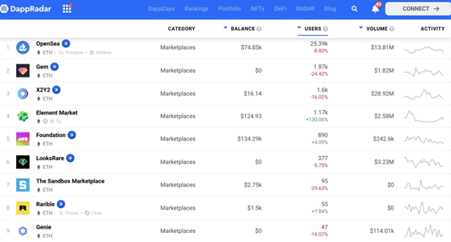
Source:
However, I have recently noticed an aggregator that is growing rapidly. Reviewing the latest data from Dappradar NFT, Element now has 1170 users in 24 hours, and 2.58 million transaction volume. Element has already surpassed Giene, the second largest aggregation market, and has great potential to surpass GEM. Next, I went to Dune Analytics to check Element’s transaction history data. Since April 15, the multi-chain transaction volume of Element 2.0 has reached 143.22 million US dollars, worth 110,169 Ethereum tokens, and a total of 58,934 unique user addresses have completed 91,599 transactions.

Source:
After thorough research, I found that the element product team was actually founded last year, it has received $11.5 million in Series A investment from top-tier capital such as Sequoia, SIG, Dragonfly Capital, Draper Dragon and Ince.
After reviewing the data and the product, here, I will give you a detailed introduction to this rising star, the first community-driven multi-chain aggregated NFT marketplace.
1. Provide users with cross-market listing and bidding through aggregation, which can fundamentally solve liquidity problems
NFT is built on the ERC721 basic protocol and has the notable characteristics of being non-fungible. Compared to ERC-20 equality tokens, it is difficult to form sufficient liquidity. This is a recognized major problem in the NFT market. Therefore, whoever solves the liquidity problem will have the opportunity to be favored by traders and thus occupy more room for growth.
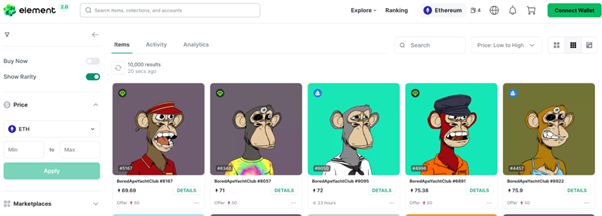
Source:
Currently, Element has aggregated NFT orders in many markets such as OpenSea and LooksRare. I learned from their Discord community that Element aggregates several order sources, such as BenDAO and Bitkeep. Not only can you buy all popular NFT collections on Element now, but you can also make sales across markets, such as a monkey country:
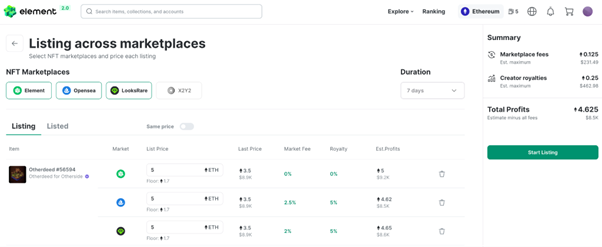
I’m trying to sell another seed#56594 right now
2. Proprietary to the ElementEx trading protocol, users can save up to 49% of gas, and optimized tools to improve trading efficiency
2.1 Savings on gas duty
When buying and selling NFTs on OpenSea, you can only do it once at a time, it will be inconvenient if you want to buy and sell many NFT pieces, especially if it is a hot collection. Meanwhile, if you want to buy the best price, you have to jump between different trading markets and waste a lot of time and gas. But if you use Element, things are different. In the process of using Element, it is obvious that the transaction gas is lower than that of OpenSea. Using Element, you can buy and sell many NFTs in one transaction. Using the ElementEx protocol (I already tested) can help you save up to 49% transaction gas, which is 39% lower than OpenSea, and even lower than Gem.

Source:
I found the reason why Element saves so much gas, the ElementEx protocol design team is very open minded and they introduced it like this:
The ElementEx Protocol development team is very open and they introduced it like this:
- Not full programming with Solidity. In fact, there is some difference in transfer cost between Solidity and assembly. The ElementEx protocol uses assembly directly for processing, which reduces the transmission costs of contract execution.
- Split ERC721 and ERC1155 contracts, and split import functions such as buy, sell, basic and advanced functions, which can reduce redundant calculations.
- The order status is stored in binary bits, and the fields of the order structure are multiplexed bit by bit, and the slots are reused to improve efficiency and reduce costs.
If it looks complicated, the author summarizes it in three key points, which are relatively advanced processing to reduce transmission costs, reduce process computation redundancy and improve storage efficiency.
It is estimated that using the ElementEx protocol can reduce gas by almost 49%, and the speed and performance of contract interaction has also improved, surpassing the Seaport protocol of industry giant OpenSea. The author deeply admires the strong technical strength of the team and the thorough understanding of trade contracts.
The completeness of the ElementEx protocol development has extended some features with strong tools. These features significantly simplify operations and improve execution efficiency in the transaction process. For example bulk purchases, collection offers and mixed payments, swipe mode. The development team also offers complete OpenAPI and SDK. If you are interested in the API, you can check the relevant information. By the way, their code is already audited by certik.
2.2 Collection offer
I use the fundraising offer a lot and I have already found low-cost NFTs through the Offer several times, but it is still a waste of time to operate the Offer one by one. When you want to buy an NFT without caring about the appearance, but only the price, you can offer a valuable price and see who takes the offer. All holders can see your offer when you make a collective offer. It works like this:
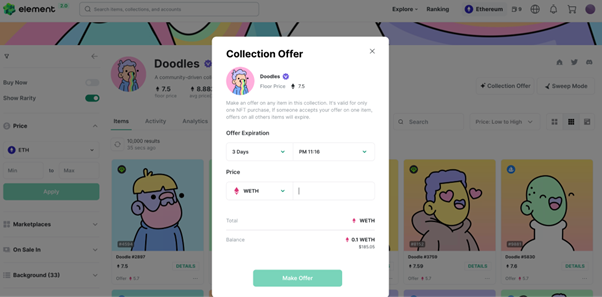
Source:
2.3 Sweep mode
Buying in bulk has made the transaction process significantly easier, but it is not smooth enough to use. I’ve experienced Element’s fast sweep, exquisite sliding design, and consistent floor price from low to high. Select NFTs in groups and add shopping With one-click car buying, the user experience becomes more and more detailed.
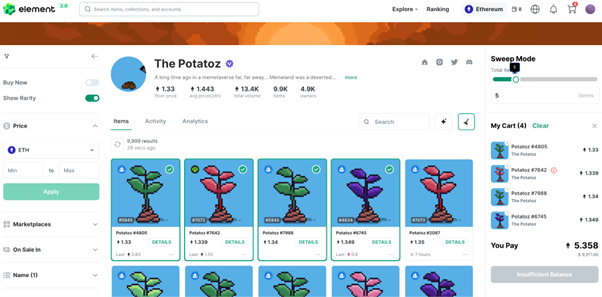
Source:
3. Based on full-chain data processing ability, minute-level multidimensional data tracking
Markets are battlefields, good deals race against time, and data is a beacon. Users can easily obtain various key data indicators that contribute to decision-making, and which need complete data processing capabilities as a basis. Complete data processing flow:
- Data collection: Obtain original on-chain data from blockchain nodes;
- Data processing: Extract, transform and load raw data in the form of stream processing or batch processing;
- Data integration and analysis: The data will be aggregated and calculated, and the results of the operation will be reported and sent out in real time.
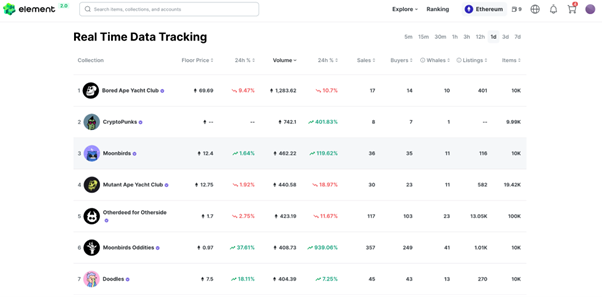
Source:
Element releases the results of data integration, providing real-time tracking and updating of chain data at the minute level, including transaction volume, floor price, number of buyers and sellers, number of whale positions, number of holders and number of quotation orders. What I enjoy about the data is real-time, from 5 minutes to 7 days, with real-time updates in seconds. Another point is to increase the number of whale users and the number of buying and selling addresses.
4. Visualize data charts to help users make investment decisions
Mining data on the chain can provide continuous Alpha benefits. Element relies on complete data processing capabilities to provide beautiful visual data charts. In comparison, the data charts provided by other NFT trading markets are actually too simple. But it is still not enough and I really hope that the product team will work on this point.
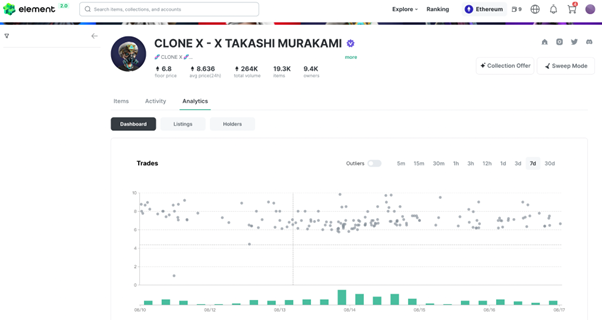
Source:
It is found that the transaction price dispersion chart of Element is a tax data tool, which clearly shows the trend of price fluctuations, the intensive transaction area, the relationship between volume and price, etc., to see the corresponding pressure level, support level, volume and price deviation, rise and fall. It helps you choose the trading time.
5. The ecological atmosphere in the community is quite good, former OpenSea community manager Edd has already joined the team
A strong blockchain is built on the basis of community consensus. Whether it’s the infrastructure layer or the application layer, even the best technologies and products need community support and contributions. On the other hand, an ideal community grows on Earth with application scenarios and continuous business development. The core team develops products, the community supports and recommends products, and product iteration relies on community feedback, and so on.
Element has such an atmosphere. The author learned through deep understanding of the Element community that community members communicated and shared enthusiastically, recommended useful tools, introduced NFTs to play new assets, and some Mods are in full swing for conversion and support from new users.
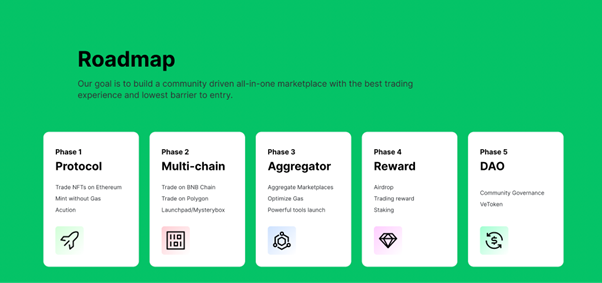
Source:
As can be seen on the homepage of the Element brand, the goal is to create a community-driven all-in-one aggregated trading market, and the gradual realization of project DAO management through Token and community management is also clearly written in the roadmap.
Element has useful products as a basis. Community-driven is the driving force for sustainable development of the project’s ecology. In addition to suggestions and voting during community governance, it can also vote for the iterative direction of Element’s functional modules. The role of the baton in ecological development. Recently, the community is eagerly awaiting the launch of the batch order feature. The element development team responded positively and completed feature development. The community has received rave reviews from the development team.
On the other hand, members of the community can be incentivized for their contribution to the ecology, such as inviting new users to join, conducting buy and sell transactions to promote liquidity and other contributors to the ecology. Continue to build community consensus and promote healthy ecological development. More importantly, I heard they are looking for KOLs right now to start ELE DAO.
6. Multi-chain strategy
NFT is not only on Ethereum.
Entering Element’s official website for the first time will clearly and intuitively show the integrated chain ecology, and they provide diversion pages based on various blockchain trading markets. This is significantly different from the way OpenSea integrates with several public chains such as Ethereum, Polygon and Solana. After entering a particular blockchain market, the system defaults to your next entry.
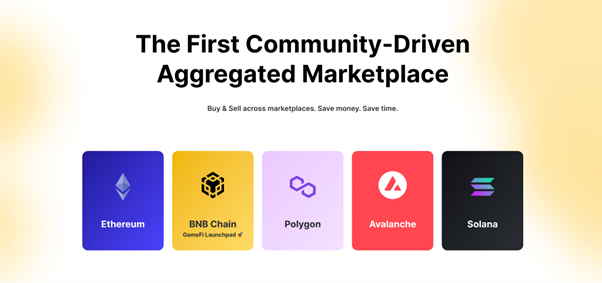
Source:
Could Element 2.0 be the next generation aggregate marketplace?
In the 1990s, in the early days of the Internet, most Internet companies devoted their efforts to providing various website content for Internet users, such as content portals such as Yahoo and AOL. It was a turbulent wave, and a large number of industrial companies and assets joined the content war, the so-called ICP era. At the time, however, two young people believed that allowing users to “conveniently acquire content” was more important than the content itself, and founded Google with this in mind.
Currently, only more than 1 million users have completed NFT transactions in the world, and a very small number of top NFT projects account for the vast majority of transaction volume. However, with the continuous emergence of various types of Web3 projects, NFT, as the basic asset layer of Web3, funds and users will continue to come in, and the development area of the NFT trading market will also expand. Just as we have seen the growth of cryptocurrency trading users from millions in 2017 to hundreds of millions today, we will also witness the scale of NFT trading users reaching hundreds of millions.
In this sense, the development of the NFT market is only in the initial phase. Most trading markets are still dealing with the level of users buying and selling NFT assets, and Element is already working on how to make users “more efficient, convenient and affordable.” Trading NFTs”, expect Element to grow into a unicorn in the Web 3 field.
Source links:
Official website: https://element.market/
Product documentation: https://docs.element.market/welcome-to-element/
For developer:

























